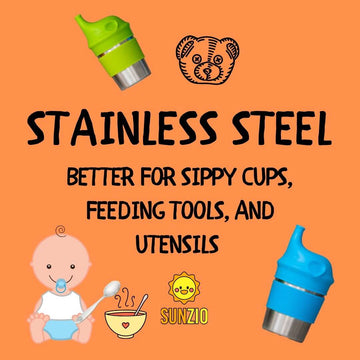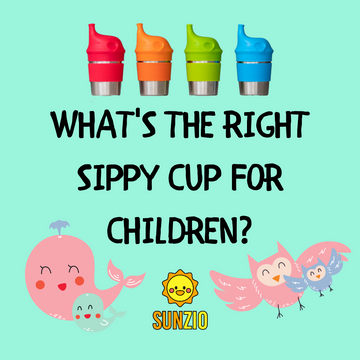Stainless Steel: Better for Sippy Cups, Feeding Tools, and Utensils
by chand baldha on Jan 30, 2023

When choosing feeding products such as cups, plates or flatware for your child, you might often find yourself gravitating to ones made of plastic. They are colorful, convenient, and of course, have a cheap price tag. But there is more than what meets the eye here. Plastic is harmful and leaches chemicals that can put a child’s health and development at risk. When it comes to products used for feeding, it’s better to skip plastic altogether and go for a much safer material like stainless steel.
In this blog post, we share with you the key reasons why stainless steel is a superior material compared to plastic when it comes to feeding your child. Stainless steel has been replacing a lot of children’s products in the market lately as parents look for safer alternatives to plastic, and we hope you too will make the switch after reading this!
3 Reasons Why Stainless Steel is Best
1. Stainless Steel is Much Safer
First of all, stainless steel has superior hygienic properties. When you sterilize your kid’s plastic cups, there is a whole lot more going on under the surface that you might not be aware of. Bacteria and germs can be killed, but many plastic products can leach an endocrine-disrupting chemical called bisphenol-A (BPA) when heated. This means it is unsafe to put plastic products in the dishwasher. That’s a big minus for convenience! Additionally, the smell of food or drinks like milk can stick to the lining of plastic when heated or cooled. Gross!
Stainless steel products are odor-resistant and can be cleaned in the dishwasher. They can also be sterilized in boiling water without the leaching of any chemicals because, you guessed it – there simply aren’t any chemicals to leach! It is a non-toxic material made of natural elements and is completely void of nasty chemicals such as BPA.
What exactly is BPA anyway?
BPA or Bisphenol-A is an organic synthetic compound – a chemical produced in large quantities for use primarily in the production of polycarbonate plastics and epoxy resins. The toxic chemical has been linked to causing reproductive, immunity, and neurological problems, as well as an increased likelihood of Alzheimer’s, childhood asthma, metabolic disease, type 2 diabetes, and cardiovascular disease.
BPA is also linked to tooth enamel problems, especially in children. It can cause white spots and damage to the tooth enamel, making it fragile or brittle and possibly more susceptible to pain, cavities and decay.
We all have heard by now to avoid BPA, and many products are indeed marketed as “BPA-Free,” but there can be other toxic additives in BPA-Free products, such as:
- BPS and BPF – recent research reveals these may be just as harmful as BPA in hormone disruption
- Phthalates – interfere with hormonal mechanisms and immune function
- Polyvinylchloride – can cause reproductive, developmental, and immune problems
- Dioxins – a group of highly toxic chemical compounds that are harmful to human They can cause problems with reproduction, development, and the immune system. They can also disrupt hormones and lead to cancer.
A big reason we should avoid using plastic feeding products with our kids is that these products are always in their mouth. Kids tend to bite and chew on these products, which is an easy way for all of these harmful chemicals to leach and possibly be digested. So when it comes to feeding: STAY AWAY FROM PLASTIC! Although it’s impractical for most of us to eliminate plastic from our lives entirely, we can’t make any compromises when feeding our children.
Other Chemicals Hiding Out in Plastic:
- Bromine – displaces iodine in the body, and is a central nervous system depressant. It can accumulate over time, and trigger paranoia and other psychotic symptoms.
- Estrogenic Chemicals – can disrupt your hormones and even alter the development of your cells, which puts infants and children at even greater risk
- Styrene – a suspected nerve toxin and carcinogen
- Antimony – considered to be a carcinogen, increases when they are exposed more to heat
Bye-Bye Mold!
In addition to being chemical free, products made of stainless steel do a better job of keeping mold and other bacteria at bay. Mold spores thrive on porous surfaces, and that is why clean stainless steel isn’t a conducive environment for mold development.
When mold is digested, it can give your child stomach pains, nausea and vomiting or diarrhea. Some children develop allergic reactions, most commonly respiratory allergic reactions to mold. Take your child to the pediatrician if you ever see any of these symptoms.
2. Stainless Steel is Way More Durable
In addition to plastic not being safe and posing a threat to children, it isn’t durable in the long run. We have all probably bought something before that was cheap and then ended up having to throw it away weeks or months later because it broke or became worn out. Plastic feeding products can easily get scraped and become brittle with time, making the lifespan of such products very short. If you have multiple kids, you won’t be passing on plastic utensils and dishes to your child’s younger siblings, which isn’t cost-effective at all.
Let’s Talk Sippy Cups
Drinking from sippy cups is a stage that all children go through. Plastic sippy cups do have the advantage of preventing spills when dropped, but for all the safety issues already mentioned, they simply aren’t worth the risk.
We designed our stainless steel sippy cups to be completely void of plastic. Stainless steel is not a good material for the lid of a sippy cup (ouch!), so we use 100% food grade silicone. Silicone might not be as durable as plastic when it comes to sippy lids, but we offer free lid replacements to our customers if any lids should rip. Of course, the stainless steel cup itself is completely durable. Even after all the drops during the sippy stage, your child will still have the same safe and shiny cup to use without the sippy lid when they are ready to drink without it!
Product Lifespan
Products made from a quality grade of stainless steel can be passed on from one generation to the next if taken care of properly. Quality grades of stainless steel offer superior corrosion resistance and won’t crack or break even if dropped on the ground. These products might be more expensive, but they will be with you for years and can be reused indefinitely.
Stainless steel can also withstand high and low temperatures, which is why it is used for cooking and food preparation. It can also be stored in the freezer without it changing the taste or consistency of the food in contact with it.
Quality Over Quantity
When it comes to design, stainless steel looks classier and more elegant. Plastic just looks cheap. And if something is cheap, there is a reason for that. When it comes to the utensils used to feed your child, it should always be quality over quantity. They are worth the extra money you pay for them.
What Kind of Stainless Steel?
Not all grades of stainless are equal. We recommend all grades of stainless steel over plastic, but even among types stainless steel, it is important to choose certain grades. For cups, plates, dishes, etc. we recommend 18/8 (304) grade, and for silverware we recommend 18/10 grade. More detailed information on this to come, so stay tuned!
3. Stainless Steel is Eco-Friendly
Stainless steel is one of the most sustainable materials on the planet. It is reusable and 100% recyclable, so it isn’t harmful to the environment. Stainless steel products can easily be recycled to produce more stainless steel products, creating a continuous cycle of sustainability. It is estimated that about 80% of stainless steel products are recycled, and a newly manufactured stainless steel object will have an average recycled content of about 60%.
Stainless steel doesn’t degrade when recycled. And since it is not coated with any toxic materials, it doesn’t produce toxic run-off. Scrap metal is the primary raw material for the production of stainless steel products, with up to 70% of the final product coming from recycled material! Increased efficiency in production technology has also decreased the amount of energy required to manufacture stainless steel.
Even if stainless steel is not recycled and it does find its way to a landfill or disposal site, it will have no detrimental effect to the soil or groundwater. Stainless steel is the preferred material for green building throughout the world. Its impact on the environment is minimal compared to other materials, and its life impact reduces significantly as it is used and recycled.
Switch for the Better for Your Child
I’m sure you have seen a lot of information about the consequences of plastic, whether on TV or scrolling through your Facebook newsfeed. We also want to make you aware of the dangers of these products, especially when it comes to feeding your children. Choosing feeding products with care is a big part of raising happy and healthy children, and we are committed to providing you with as much information as possible to help you out with this.
Companies and individuals can both make a huge difference to the current environmental crisis by simply choosing stainless steel over plastic when it comes to food preparation and storage. And you can make this switch starting at the most urgent and necessary point: feeding your kid(s). So be a little selfish and think first about the health and safety of your family. That will also be the best way to help the environment. A TRUE WIN-WIN!
Sources:
- https://sassda.co.za/about-stainless/stainless-steel-and-the-environment
- https://www.mnn.com/health/fitness-well-being/blogs/bpa-its-also-bad-for-your-teeth
- https://shopkablo.com/blogs/the-reformist/dangerous-side-effects-of-bpa-plastic
- https://www.niehs.nih.gov/health/topics/agents/sya-bpa/index.cfm
- sustainablestainless.org/why-stainless




